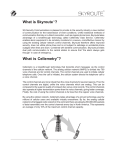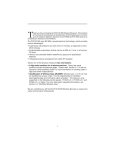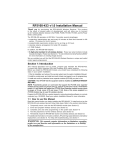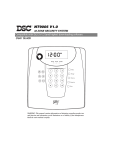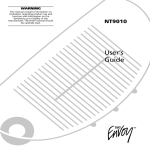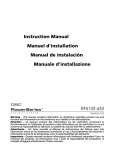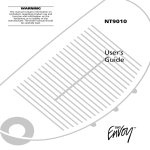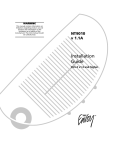Download DSC PC580 - V2.3 Installation manual
Transcript
WARNING: Please refer to the System Installation Manual for information on limitations regarding product use and function and information on the limitations as to liability of the manufacturer. Installation Manual LCD55 O1Z32-433 NA DLS-3 v1.3 or higher version 4.1 Table of Contents T A B L E O F C O N T E N T S Introduction 1 Section 1: Installation 2 1.1 1.2 1.3 1.4 1.5 2 2 2 3 3 Unpacking ................................................................................................................. Mounting .................................................................................................................... Wiring .......................................................................................................................... Applying Power ......................................................................................................... Enrolling the Keypad ................................................................................................ Section 2: Keypad Programming 5 2.1 2.2 2.3 2.4 2.5 2.6 5 5 5 6 6 6 Programming the Keypad ...................................................................................... Function Key Options ............................................................................................... Clock Options ............................................................................................................ Alarms Displayed While Armed Option ................................................................. Emergency (Fire, Auxiliary, Panic) Key Options ................................................... Door Chime Options ................................................................................................ Section 3: Receiver Programming Enroll & Program Devices 3.1 3.2 3.3 3.4 3.5 8 8 Electronic Serial Numbers ........................................................................................ 8 Enroll Wireless Devices Using Zones ........................................................................ 8 Enroll & Program Wireless Keys ............................................................................... 9 Identified Wireless Keys .......................................................................................... 10 Enrolling & Programming Handheld Keypads .................................................... 11 Section 4: Other Programming 12 4.1 4.2 4.3 4.4 4.5 12 12 12 13 13 Program Zones and Partitions ............................................................................... Enable Receiver Supervision ................................................................................. Enable Supervision of Wireless Zones ................................................................... RF Jam Detect Zone ............................................................................................... Receiver Software Default .................................................................................... Section 5: Testing & Mounting 5.1 5.2 Section 6: Additional Notes 6.1 6.2 15 Test the placement of wireless devices ............................................................... 15 Test WLS909 and WLS919 Reception .................................................................... 16 17 Trouble Conditions .................................................................................................. 17 Replacing Batteries in Wireless Devices .............................................................. 17 Section 7: Troubleshooting 18 Section 8: Programming Worksheets 19 Appendix A: Guidelines for Locating Smoke Detectors 26 Introduction I N T R O D U C T I O N Introduction The LCD5501Z32-433 keypad combines a standard PC5132 receiver with an LCD5501Z keypad that presents system status using an LCD-style display with fixed messages. With the addition of the keypad, the control panel will now support up to 32 zones. The LCD5501Z32-433 is compatible with the following DSC security systems: • PC5010 (all versions) • PC5015 (all versions) • PC5020 (all versions) • PC1555 v2.3 and higher • Power608 v2.3 and higher • PC5008 v2.3 and higher • PC580 v2.3 and higher NOTE: Control panels previous to version 2.3 support 8 wireless zones. NOTE: Only one LCD5501Z32 keypad can be connected per system. If more keypads are required please select other DSC compatible keypads for the system being installed. Specifications and Features • • • • • Maximum Current Draw: 260mA (with back lighting boost on) Frequency: 433.92 mHz Zones - receiver can receive signals from up to 32 wireless zones Supervisory - programmable supervisory window, one to 24 hours Location - can be wired up to 1000 ft. / 305 m from the main panel with 22 gauge wire - for longer wire runs, thicker gauge wire must be used. • Compatibility: The LCD5501Z32-433 can be connected to the following panels: PC5010, PC5015, PC5020, PC5008, PC1555, PC580 • Connects to control panel via 4-wire Keybus • One keypad zone input • Optional tamper version • Five programmable function keys • Ready (green), Armed (red) and Trouble (yellow) status lights 1 Installation S E C T I O N 1 1.1 Unpacking The LCD5501Z32-433 package includes the following par ts: parts: • • • • • • • One LCD5501Z32-433 keypad One 5.6K Ohm resistor Four mounting screws One keypad inner door label One set of Fire, Auxiliary and Panic key labels One LCD5501Z User Sheet One LCD5501Z32-433 Installation Manual 1.2 Mounting You should mount the keypad where it is accessible to designated points of entry and exit. Once you have selected a dry and secure location, perform the following steps to mount the keypad: 1. Remove the keypad backplate by loosening the screw located at the base of the unit. 2. Secure the keypad backplate to the wall in the desired location. Use the screws provided. 3. Before attaching the keypad to its backplate, complete the keypad wiring as described in the next section. 1.3 Wiring 1. Before beginning to wire the unit, ensure that all power (AC transformer and battery) is disconnected from the control panel. 2. Connect the four Keybus wires from the control panel (red, black, yellow and green) to the keypad terminals (R B Y G). Consult the diagram below: 3. You can connect a device, such as a door contact, to the “Z” terminal of the LCD5501Z32433. This eliminates the need to run wires back to the control panel for the device. To connect the zone, run one wire from the device to the Z terminal and the other wire from the device to the B (black) terminal. For powered devices, run the red wire to the R (positive) terminal and the black wire to the B (negative) terminal. When using end of line supervision, connect the zone according to one of the configurations outlined in your system’s Installation Manual. 2 I N S T A L L A T I O N 1.4 Applying Power Once all wiring is complete, apply power to the control panel: 1. Connect the battery leads to the battery. 2. Connect the AC transformer. For more information on control panel power specifications, see the control panel Installation Manual. NOTE: Do not connect the power until all wiring is complete. 1.5 Enrolling the Keypad Once all wiring is complete, you will need to enter a 2-digit number that tells the system the partition and slot assignment of the keypad. If your system has partitions, you will also need to assign the keypad to a partition (1st digit). The slot assignment (2nd digit) tells the panel which keypad slots are occupied. The panel can then generate a fault when a keypad supervisory signal is not present. There are eight available slots for keypads. LCD5501Z32-433 keypads are always assigned to slot 1 by default. You will need to assign each keypad to its own slot (1 to 8). NOTE: The LCD5501Z32-433 enrolls as two modules: 1 = keypad section of the LCD5501Z32-433 17 = receiver section of the LCD5501Z32-433 Enter the following at each keypad installed on the system: 1. 2. 3. 4. Enter Installer Programming by pressing [*][8][Installer’s Code] Press [000] for Keypad Programming Press [0] for Partition and Slot Assignment Enter a two digit number to specify the partition and slot assignment. NOTE: If your system does not have partitions, enter [1] for the first digit. 1st digit Enter 0 for Global Keypad Enter 1 for Partition 1 Keypad Enter 2 for Partition 2 Keypad 2nd digit Enter 1 to 8 for Slot Assignment 5. Press the [#] key twice to exit programming. 6. After assigning all keypads, perform a supervisory reset by entering [*][8][Installer’s Code][902]. The panel will now supervise all assigned keypads and enrolled modules on the system. To review which modules the control panel is currently supervising: 1. Enter [✱][8][Installer’s Code] 2. Enter [903] to display all modules. On the LCD5501Z32-433 keypad, 1 and 17 will scroll on the keypad to indicate that the LCD5501Z32-433 is present on the system. 1 designates the keypad section, and 17 is used to show the receiver section is also supervised. If using an LCD5501Z keypad, scroll until the module name appears on the display. 3. To exit press [#]. 3 I N S T A L L A T I O N If both modules do not show on the keypad, one of the following conditions may be present: • the keypad is not connected properly to the Keybus • there is a problem with the Keybus wiring run • the keypad does not have enough power 1.6 Downloading This product has an integrated PC5132-433 v4.1 receiver. When downloading to this keypad, please select the PC5132-433 v4.1 file. DLS-3 v1.3 and greater must be used in order to have the capability of downloading to this keypad. 4 Keypad Programming S E C T I O N 2 2.1 Programming the Keypad There are several programming options available for the LCD5501Z32-433 keypad. These are described below. Record all your programming choices in the programming worksheets included in this manual. Programming the LCD5501Z32-433 is similar to programming the rest of the system. When you are in the LCD5501Z32-433 programming sections, the keypad will display which options are turned on along the top of the display. To turn an option on or off, press the number corresponding to the option on the number pad. The numbers of the options that are currently turned ON will be displayed. For example, if options 1 and 2 are on, the display will look like this: For information on programming the rest of your security system, please refer to your system’s Installation Manual. 2.2 Function Key Options The function keys are programmed in sections [1] to [5]. By default, the 5 function keys on the keypad are programmed as Stay Arm (03), Away Arm (04), Chime (06), Sensor Reset (14) and Quick Exit (16). You can change the function of each key on every keypad. Please see your system’s Installation Manual for instructions on programming the keys, and a complete list of all the function key options available for your system. 2.3 Clock Options The LCD5501Z32-433 will display the current time after 30 seconds of no key presses. To set the correct time and date for the system, please refer to your system’s Instruction Manual. You can change how the keypad displays the time with the following options. To change the clock options: 1. Enter [*][8][Installer’s code] 2. Enter [000] to go to keypad programming 3. Enter section [6] to go to clock options. 4. To turn any of the options on or off, press [1], [2], or [3]: NOTE: If the Time does not display on keypad option is selected, make sure that the Keypad displays time when zones are open option is also selected. [1] ON = Time displays on keypad OFF = Time does not display on keypad [2] ON = Clock display is in AM/PM format (e.g. 08:00 AM) OFF = Clock display is in 24-hour format (e.g. 20:00) [3] ON = Keypad does not display time when zones are open OFF = Keypad displays time when zones are open 5. When you are finished programming the clock options, press [#] to exit. 5 K E Y P A D P R O G R A M M I N G 2.4 Alarms Displayed While Armed Option You can disable the display of alarms on the keypad when the system is armed. The display of alarms is enabled by default. To disable the display of alarms when the system is armed, turn off section [6], option [5]: 1. Enter [*][8][Installer’s code] 2. Enter [000] to go to keypad programming 3. To turn the display of alarms on or off, enter section [6]. 4. Turn option [5] on or off: [5] ON = Alarms not displayed while system is armed OFF = Alarms are always displayed while system is armed 5. When you are finished, press [#] to exit. 2.5 Emergency (Fire, Auxiliary, Panic) Key Options You can enable or disable the Fire, Auxiliary and Panic keys at each keypad. These keys are enabled by default. Please see your system’s Installation Manual for more information on these keys and their options. To turn any of the emergency keys on or off on the keypad: 1. Enter [*][8][Installer’s code] 2. Enter [000] to go to keypad programming 3. Enter section [7]. 4. To turn the emergency key options on or off, press [1], [2], or [3]: [1] ON = Fire key enabled OFF = Fire key disabled [2] ON = Auxiliary key enabled OFF = Auxiliary key disabled [3] ON = Panic key enabled OFF = Panic key disabled 5. When you are finished, press [#] to exit. 2.6 Door Chime Options You can program the LCD5501Z32-433 keypad to sound a tone when any zone is opened or closed. There are two parts to the LCD5501Z32-433 door chime programming: • Program if the LCD5501Z32-433 will chime when zones are opened and/or closed. • Program the type of sound the LCD5501Z32-433 will make when an individual zone is opened or closed. For the door chime feature to work, you will also need to turn on the Door Chime attribute for each zone that will trigger the chime. This programming is done in the control panel software. Refer to your control panel’s Installation Manual for more information. Door Chime on Zone Openings/Closings You can program each LCD5501Z32-433 keypad to sound a door chime when zones are opened and/or when they are closed. By default, LCD5501Z32-433 keypads are programmed to sound door chimes on both zone openings and closings. To change the door chime opening/closing settings, at each LCD5501Z32-433 keypad: 6 K E Y P A D P R O G R A M M I N G 1. Enter [*][8][Installer’s code] 2. Enter [000] to go to keypad programming 3. Enter section [6]. 4. To turn the options on or off, press [6] or [7]: [6] ON = Door Chime Enabled for Zone Openings OFF = Door Chime Disabled for Zone Openings [7] ON = Door Chime Enabled for Zone Closings OFF = Door Chime Disabled for Zone Closings 5. When you are finished, press [#] to exit. Door Chime Sounds You can program the LCD5501Z32-433 keypad to make different door chime sounds for individual zones, or groups of zones. Each LCD5501Z32-433 keypad can make any of four door chime sounds for each zone that triggers the door chime: · · · · 4 quick beeps (default sound) ‘Bing – Bing’ tone ‘Ding – Dong’ tone ‘Alarm’ tone NOTE: For a zone to be able to trigger the door chime sound, the Door Chime zone attribute must also be enabled in the control panel programming. Please see your control panel Installation Manual. To change the door chime sounds: 1. Enter [*][8][Installer’s code]. 2. Enter [*] to go to door chime sound programming. 3. Enter a 2-digit number for the zone you want to program [01] - [32]. 4. Turn one of the following options on by pressing [1], [2], [3], or [4]: [1] [2] [3] [4] 4 quick beeps (default sound) ‘Bing – Bing’ tone ‘Ding – Dong’ tone ‘Alarm’ tone NOTE: Make sure that only one of the above options is turned on. If more than one is on, the keypad will sound the first option that is enabled. If none of the options are selected, the keypad will not make any sound when the zone is opened or closed. 5. To program the door chime sound for another zone, repeat steps 3 and 4. 6. When you are finished programming the door chime sounds, press [#] to exit. 7 Receiver Programming S E C T I O N 3 Enroll & Program Devices This section describes how to enroll and program: • wireless devices using zones (WLS904P, WLS906, WLS907, WLS912, WLS914 and WLS925L) • wireless keys (WLS909, WLS919) For more information on these devices, read the instruction sheet included with each device. 3.1 A Note about Electronic Serial Numbers An electronic serial number (ESN) is printed on the back of each wireless device. ESNs are used to enroll the wireless devices with the LCD5501Z32-433 keypad. In order to reduce the occurrence of wireless devices with the same serial number, 6digit serial numbers are now printed on the back of each wireless device. NOTE: 6-digit serial numbers are only supported on the following control panels: PC5010 v2.x and higher, PC5015 v2.2, PC5020, PC5008, PC1555 and PC580. The 6-digit serial numbers include hexadecimal digits. For instructions on programming, hexadecimal numbers, see your system Installation Manual, section 4: How to Program. When connecting the LCD5501Z32-433 to a PC5010, PC5020 or PC5015 v1.x panel, enter 5-digit serial numbers only. When connecting the LCD5501Z32-433 to a PC5010 v2.x, PC5015 v2.x, PC5020, PC5008, PC1555 or PC580 panel follow the instructions below. Old Wireless Device ESNs You can use older devices on all versions of the LCD5501Z32-433 keypad, even though they only have a 5-digit ESN. When using older wireless devices: Enter [0] + 5-digit ESN 3.2 Enroll Wireless Devices Using Zones Enroll wireless devices which use zones (universal transmitters, motion detectors, smoke detectors, and panic pendants): 1. At a system keypad, enter [✱][8][Installer’s code] to go the installer’s programming section. 2. Enter programming section [804]. 3. Enter the 2-digit number corresponding to the zone the device is to occupy ([01] to [32]). NOTE: Hardwired and wireless devices cannot be assigned to the same zone. PC5108 zone expander modules occupy zones in 2 groups of 4 (e.g. zones 9-12 and zones 1316). None of the zones assigned to a PC5108 module may be used for wireless devices. For more information on zone assignment, consult your system Installation Manual. 4. Enter the device’s ESN. The entry must be six digits. If an older device with a 5-digit ESN is being enrolled, add the digit [0] to the beginning of the ESN. (E.g., ESN=21234, enter 021234) 8 E N R O L L & P R O G R A M D E V I C E S 5. The device is now enrolled on the system. Record the serial number and the assigned zone number in the programming worksheets in the back of this manual. 6. Continue with steps 3 - 5 until you have enrolled all wireless devices. 7. To exit press [#]. NOTE: The devices will not work properly until you complete zone and partition programming (see section 4). 3.3 Enroll & Program Wireless Keys (WLS909/WLS919) For wireless keys to work on the system, you need to enroll them and then program the function buttons. Wireless keys are not assigned to zones and require no zone programming. You can enroll up to 16 wireless keys on the system. Enroll Wireless keys 1. At a system keypad, enter [✱][8][Installer’s code] to go to the Installer’s Programming section. 2. Enter programming section [804]. 3. Enter a 2-digit number [41]-[56] to assign the wireless key a slot. These numbers correspond to wireless key numbers 01-16. 4. Enter the key’s ESN. The entry must be six digits. If an older key with a 5-digit ESN is being enrolled, add the digit [0] to the beginning of the ESN. (E.g. ESN=61234, enter 061234) 5. The key is now enrolled on the system. Record the serial number and the assigned slot number in the programming worksheets in the back of this manual. 6. Repeat steps 3 - 5 until all wireless keys have been enrolled. 7. (PC5010, PC5020 and PC5015 only) By default, all wireless keys are assigned to Partition 1. To assign keys to Partition 2, enable the appropriate options in programming sections [91] and [92]. NOTE: A wireless key can only be assigned to one partition. 8. To exit press [#]. Program the WLS909/WLS919 Function Buttons WLS909 wireless keys have four programmable function buttons. You must program a set of four functions for the buttons before any keys will work. After the functions are programmed, when you press and hold one of the four buttons for two seconds, the system will execute the programmed function. For systems not using partitions: program the function buttons in section [59]. All wireless keys will have the same four functions. For systems using 2 partitions (PC5010, PC5020 and PC5015 only): all wireless keys assigned to Partition 1 will have the four functions programmed in section [59]. All wireless keys assigned to Partition 2 will have the four functions programmed in section [60]. For example, if function button 1 in Section [59] is programmed for Stay arming, then pressing the first button on wireless keys assigned to Partition 1 will Stay arm Partition 1. NOTE: Wireless keys will not work when the partition they are assigned to is being accessed for zone bypassing or programming. 9 E N R O L L & P R O G R A M D E V I C E S 1. At a system keypad, enter [✱][8][Installer’s code]. 2. Enter programming section [804]. 3. Enter programming section [59] for keys assigned to partition 1, or [60] for keys assigned to partition 2. 4. For each of the 4 function buttons, enter the 2-digit number of the function you want to select. See the programming worksheets for a list of function key options. 5. Record your programming choices in the worksheets in the back of the manual. 6. To exit press [#]. 3.4 Identified Wireless Keys Reporting by the system of openings/closings by individual wireless keys and command output [✱][7] activation by wireless key buttons may be supported on certain control panels. To do this, the system will reserve access codes 17 – 32 for wireless keys 01-16 respectively. You must program one access code for each wireless key (using [✱][5] access code programming) for this feature to work correctly. Refer to your system Installation Manual for information on access code programming. Opening/Closing By Wireless Key Reporting NOTES: The Identified Wireless Key Closing option is only available with the PC5010 v2.0, PC5020, PC5008 v2.0 and higher by turning section [015] option 4 off. The Identified Wireless Key Opening option is only available with the PC1555 v2.1, PC580 v2.1, PC5008 v2.1 and higher, PC5015 v2.2 and higher by turning Section [017] Option 1 off. To enable the reporting of closings by identified wireless keys: • • • • Make sure the control panel is v2.0 or higher Program a valid access code for each key Program a closing reporting code for each key’s access code Disable the Quick Arm option in section [015] option [4] To enable the reporting of openings by identified wireless keys: • • • • Make sure the control panel is v2.1 or higher Program a valid access code for each key Program an opening reporting code for each key’s access code Enable the WLS Key Uses Access Codes by turning section [017] option [1] off. Command Output Activation NOTE: The Identified Wireless Key Command Output Activation feature is only available with the PC5010, PC5020, PC5015, PC5008, PC1555 and PC580 v2.0 and higher. To enable command output activation by wireless keys, do the following: • Make sure the control panel is v2.0 or higher • Program a valid access code for each key • Enable the PGM output attribute Requires Access Code for each PGM output programmed as [✱][7][1-4] in sections [141] to [154]. 10 E N R O L L & P R O G R A M D E V I C E S 3.5 Deleting Wireless Devices To remove a wireless device from the system, follow the guideline for adding a wireless device. Program the ESN as [000000]. The wireless device for the zone will be removed. NOTE: You may need to remove power from the panel in order to clear troubles caused by deleted zones. Now that you have enrolled all the wireless devices, you will need to program the system to work properly with the devices. See section 4 for more information. 11 Other Programming S E C T I O N 4 4.1 Program Zones and Partitions Now that you have enrolled the wireless devices, you should complete all zone programming on the system. Although the exact programming required varies depending on which control panel the LCD5501Z32-433 is connected to, you should check that the following programming areas are completed correctly for each wireless zone: • Enable zones and/or assign zones to one or more partitions (programming sections [201]-[209]). • Program the definition for each zone (programming sections [001]-[004]). NOTE: WLS906 wireless smoke detectors must be assigned to zones defined as Delay 24-hr fire (wireless) [87] or Standard 24-hr fire (wireless) [88] for proper supervision. • Enable the wireless zone attribute for each wireless zone (PC580, PC1555, PC5008, PC5010 v2.0 and higher, PC5020, PC5015 v2.2 and higher only) (programming sections [101]-[132]). See your system Installation Manual, for more information on each of the above programming sections. 4.2 Enable Receiver Supervision The control panel will automatically supervise the receiver via the Keybus one-minute after at least one device has been enrolled on the module. The system will generate a General System Supervisory trouble if the module is removed from the Keybus. If you need to remove the LCD5501Z32-433 from an existing system, you will have to disable supervision of the PC5132. 4.3 Enable Supervision of Wireless Zones NOTE(for PC5010 v1.x control panels only): For UL Listed installation, Double EOL resistors must be enabled in the PC5010 for the wireless zones to be supervised. If normally Closed or Single EOL resistors are selected the PC5010 will not be able to supervise the wireless devices. If a wireless device stops sending a supervisory signal (the unit stops functioning) the panel will not indicate a supervisory trouble condition unless Double EOL resistors are used. In addition, all hardwire zones must be wired for Double EOL resistors. For more information, refer to your PC5010 v1.x Installation Manual. NOTE (PC5010 v2.0 and higher, PC5015 v2.2 and higher, PC5020, PC5008, PC1555, PC580 only): For wireless supervision to work, you must enable the wireless zone attribute on all wireless zones (sections [101] to [132], option [8] ON). NOTE: The RF Jam Detect zone must have the supervision option disabled. Wireless Supervisory Window Each wireless zone (WLS904P, WLS906, WLS907, WLS912, WLS914, WLS925L) will send a supervisory signal every 64 minutes. If the receiver does not receive a signal within the time programmed for the Wireless Supervisory Window, it will generate a supervisory fault. 12 O T H E R P R O G R A M M I N G To program the wireless supervisory window: 1. Enter [✱][8][Installer Code] to enter Installer Programming. 2. Enter [804] to enter into Receiver Programming. 3. Enter sections [81]. 4. Enter the time period for the supervisory window (8 to 24 hours). 5. To exit press [#]. Disable/Enable Zone Supervision All wireless zones have supervision enabled by default. To disable supervision for any zone, enter the following at any system keypad: 1. Enter [✱][8][Installer Code] to enter Installer Programming. 2. Enter [804] to enter the PC5132 Module Programming. 3. Enter sections [82], [83], [84] and [85]. Disable or enable supervision for each wireless zone by turning each relevant option on or off. 4. To exit press [#]. 4.4 RF Jam Detect Zone For RF jamming detection to work, you must select an unused zone to be used as the RF Jam Detect zone. When the receiver detects an attempt to jam the RF signal, the RF Jam Detect zone will be violated and the system will generate a tamper signal. When the jamming signal is gone, the RF Jam Detect zone closes and the system sends a tamper restore signal. To enable RF jamming detection: 1. Enter [✱][8] [Installer’s Code]. 2. Enter programming section [804]. 3. Select an unused zone to be the RF Jam Detect zone. Enter the 2-digit number ([01] to [32]) of the RF Jam Detect zone on the keypad, then program the serial number as [200000]. 3. Enter section [93]. Enter the 2-digit number of the RF Jam Detect zone ([01] to [32]) in the programming section. 4. Disable supervision for the RF Jam detect zone by turning the relevant option off in section [82], [83], [84] or [85]. (See section 4.3 for more information.) 5. RF jamming detection is now enabled. To exit Installer programming, press [#]. 4.5 Receiver Software Default Returning the receiver programming to factory default settings is a quick way to remove all the enrolled devices from the system and reset all the programming in section [804]. NOTE: Performing this procedure will not change any programming sections except [804]. Resetting the control panel to factory default settings will not return the PC5132 to factory default settings. 13 O T H E R P R O G R A M M I N G To restore PC5132 to the settings, the O the T H E Rprogramming P R O G factory R Adefault M M I Nperform G following: 1. Enter [✱][8] [Installer’s Code]. 2. Enter programming section [996]. 3. Enter the Installer’s Code, followed by [996] again. Press [#]. The software for the receiver section will be restored to its factory default settings. 4. Press [#] to exit Installer Programming. After a software default, you must exit and then re-enter Installer Programming before attempting to program the receiver section. For instructions on restoring the default programming of the control panel or any other connected module, see your system Installation Manual. 14 Testing & Mounting S E C T I O N 5 5.1 Test the placement of the WLS904P, WLS906, WLS907, WLS912, WLS914 and the WLS925L It is very important to test the proposed placement of each wireless device before it is mounted. Following these steps will test the placement of the wireless motion detectors (WLS904P/WLS914), wireless smoke detectors (WLS906), wireless glassbreak detectors (WLS912) and wireless door/window contacts (WLS907/WLS925L), based on the signal strength between the LCD5501Z32-433 and the device. NOTE: You cannot test the Wireless Keys (WLS909/WLS919) in this mode. See section 5.2 for instructions on testing these devices. You cannot run a placement test on the RF Jam Detect zone. 1. 2. 3. 4 5. Temporarily place the device you want to test in the place you want to mount it. At a system keypad, enter [✱][8][Installer Code]. Enter programming section [904]. Enter the 2-digit zone number for the device to be tested. Activate the device being tested until a result is displayed on the keypad or sounded by the keypad or bell. WLS904P & WLS914: Remove the detector from its backplate, wait for 1-2 seconds, then reattach the detector to its backplate. WLS906: Remove the detector from its backplate, wait for 5 seconds, then reattach the detector to its backplate. Or hold a magnet near the raised line on the outer rim. Then remove the magnet. WLS907 & WLS925L: Open and close the contact by moving the magnet away from the unit. If the unit is attached to a door or a window, open and close the door or window to activate the device. WLS912: Press and hold the test mode tab for 5 seconds. Release the test mode tab. The keypad will display the test result. 6. Read the test results at the keypad: Result LED Keypad LCD Keypad Buzzer/Bell Good Light 1 On Steady “Good” 1 Beep/Squawk Fair Light 2 On Steady “Fair” 2 Beeps/Squawks Bad Light 3 On Steady “Bad” 3 Beeps/Squawks Activate the device until you get 3 good or fair results in a row. Wait 10 seconds between each test on the same device. You may mount wireless devices where results were good or fair. Devices indicating a bad result must be moved to another location. You may only have to move the device a few inches to correct a bad result. NOTE: Do not mount any device where a “bad” test result was indicated. If several wireless devices produce BAD test results, you may need to move the LCD5501Z32-433 to a better location. 7. To test another device, press [#] once, then repeat steps 4 - 6. Continue to test the devices until both the LCD5501Z32-433 and the devices are in good locations. 8. To exit installer programming, press [#] twice. 15 T E S T I N G & M O U N T I N G 5.2 Test WLS909 & WLS919 Reception The wireless key (WLS909) cannot be tested using the module placement test described above. To ensure that the LCD5501Z32-433 is receiving transmissions from these devices, conduct the following tests: WLS909/WLS919: Use the function keys to arm and disarm the system at several different points in the installation. If these devices do not operate from all points in the installation, you will need to move the LCD5501Z32-433 receiver. Moving the LCD5501Z32-433 higher will usually improve the reception. If you move the LCD5501Z32-433, repeat the tests described in sections 5.1 and 5.2 on all the wireless devices. Continue to test the devices until you have found satisfactory locations for the LCD5501Z32-433 and the WLS904P, WLS906 and WLS907 devices, and there is good reception between the LCD5501Z32-433 and the WLS909 device. Mount the WLS904P, WLS906, WLS907, WLS912, WLS914 and WLS925L If you have conducted the placement test described in section 5.1 and got 3 “Good” or “Fair” results in a row for each device, you can mount the wireless devices. See the Installation Sheet for each device for mounting instructions. 16 Additional Notes S E C T I O N 6 6.1 Trouble Conditions The control panel always watches for possible trouble conditions. If a trouble condition occurs, the keypad “Trouble” light will turn on and the keypad will beep. Press [✱][2] to display the trouble conditions. The following trouble conditions apply to the receiver portion (identified as the PC5132 by the panel) and/or any enrolled devices. For a description of all troubles, please see your system Installation Manual . • • • • • General System Tamper General System Supervisory Zone Fault Device Low Battery Zone Tamper Wireless Zone Low Battery Transmission Within the supervisory transmission, the device will indicate the status of the battery. If a battery is low, the system will indicate a Device Low Battery trouble. The system will delay reporting the event to the central station for the number of days programmed for Zone Low Battery Transmission Delay in section [370]. This will prevent unnecessary reporting of the event if the user has been instructed on how to replace batteries. 6.2 Replacing Batteries in Wireless Devices 1 Remove the cover of the device from its backplate. This creates a tamper condition on the zone. 2 Refer to the battery installation instructions on the Installation Sheet of each component. Be sure to note the proper orientation of the batteries as you install them. 3 When the fresh batteries are in place, re-attach the cover to the backplate. The tamper is restored and the zone sends a battery trouble restoral signal to the receiver. The battery trouble is now clear and the device should function normally. NOTE: When batteries in one device need to be replaced, the batteries in all devices should be replaced at the same time. 17 Tro u b l e s h o o t i n g S E C T I O N 7 1. When I enter the 2-digit zone number when adding a wireless device, the keypad gives me a long beep. You cannot enter ESNs unless the LCD5501Z32-433 is properly connected to the Keybus. See sections 1 & 3 for instructions on setting up and wiring the PC5132 module. 2. I have entered the ESN for the device but when I violate the device, the zone does not show open on the keypad. Check the following: • • • • Ensure the ESN has been entered correctly Ensure that the zone is enabled for the partition (if partition programming is used). Ensure that the wireless zone is not assigned to a zone used by PC5108 modules. Ensure that the zone is programmed for something other than “Null Operation.” Wireless smoke detectors must be assigned to zones defined as type [87] or [88]. 3. When I try a module placement test I get no result or “Bad” results. Check the following (see sections 5.1 and 5.2 for more information on testing devices): • Verify that you are testing the correct zone • Verify that the correct ESN was entered when the device was enrolled • Verify that the device is in range of the LCD5501Z32-433. Try testing the device in the same room as the receiver. • Confirm that the LCD5501Z32-433 is properly connected to the Keybus. • Check that you are testing the zone correctly. • Check that the batteries are working and installed correctly. • Look for large metal objects that may be preventing the signal from reaching the LCD5501Z32-433. The device must be located where consistent “Good” results are obtained. If several devices show “Bad” results, or if panic pendants and wireless keys operate inconsistently, move the receiver. 4. The LED on the motion detector does not turn on when I walk in front of the unit. The LED is for walk test purposes only. See your WLS904P Instruction Sheet for walk test instructions. 18 Programming Worksheets S E C T I O N 8 [000] Keypad Programming 1. Enter [*][8][Installer’s code] 2. Enter [000] to go to keypad programming [0] Keypad Enrollment Valid entries are 01-18; e.g. enter [11] for partition 1, slot 1. Default = 11 1st digit Enter 0 for Global Keypad Enter 1 for Partition 1 Keypad Enter 2 for Partition 2 Keypad 2nd digit Enter 1 to 8 for Slot Assignment Slot Slot: I________I________I [1]-[5] Function Key Assignments [1] Key 1 [2] Key 2 [3] Key 3 [4] Key 4 [5] Key 5 03 Stay 04 Away 06 Chime 14 Reset 16 Exit I________I________I I________I________I I________I________I I________I________I I________I________I Defaults: [6] LCD5501Z32-433 Keypad Options Default Option On Off ON I________I 1 Local Clock Display Enabled Display Disabled ON I________I 2 Local Clock Displays AM/PM Displays 24-hour Time OFF I________I 3 Open Zones Override Clock Display Do Not Override Clock OFF I________I 4 For Future Use OFF I________I 5 Alarms Not Displayed While Armed Always Displayed While Armed OFF I________I 6 Door Chime Enabled for Zone Openings Door Chime Disabled OFF I________I 7 Door Chime Enabled for Zone Closings Door Chime Disabled OFF I________I 8 For Future Use [7] Emergency Key Options Default On Off ON I________I Option 1 [F] Key Enabled [F] Key Disabled ON I________I 2 [A] Key Enabled [A] Key Disabled ON I________I 3 [P] Key Enabled [P] Key Disabled OFF I________I 4-8 For Future Use 19 P R O G R A M M I N G W O R K S H E E T S [*] Door Chime Sound Programming 1. Enter [*][8][Installer’s code][*] 2. Enter 2-digit zone number [01] - [32], then select door chime sound option [1] - [4]. Repeat for each zone that is to sound a chime. Zone Location [1] [2] [3] [4] 4 Beeps “Bing-bing”“Ding-dong”Alarm tone (default) [01] I__________________________________________________________________I I________I I________I I________I I________I [02] I__________________________________________________________________I I________I I________I I________I I________I [03] I__________________________________________________________________I I________I I________I I________I I________I [04] I__________________________________________________________________I I________I I________I I________I I________I [05] I__________________________________________________________________I I________I I________I I________I I________I [06] I__________________________________________________________________I I________I I________I I________I I________I [07] I__________________________________________________________________I I________I I________I I________I I________I [08] I__________________________________________________________________I I________I I________I I________I I________I [09] I__________________________________________________________________I I________I I________I I________I I________I [10] I__________________________________________________________________I I________I I________I I________I I________I [11] I__________________________________________________________________I I________I I________I I________I I________I [12] I__________________________________________________________________I I________I I________I I________I I________I [13] I__________________________________________________________________I I________I I________I I________I I________I [14] I__________________________________________________________________I I________I I________I I________I I________I [15] I__________________________________________________________________I I________I I________I I________I I________I [16] I__________________________________________________________________I I________I I________I I________I I________I [17] I__________________________________________________________________I I________I I________I I________I I________I [18] I__________________________________________________________________I I________I I________I I________I I________I [19] I__________________________________________________________________I I________I I________I I________I I________I [20] I__________________________________________________________________I I________I I________I I________I I________I [21] I__________________________________________________________________I I________I I________I I________I I________I [22] I__________________________________________________________________I I________I I________I I________I I________I [23] I__________________________________________________________________I I________I I________I I________I I________I [24] I__________________________________________________________________I I________I I________I I________I I________I [25] I__________________________________________________________________I I________I I________I I________I I________I [26] I__________________________________________________________________I I________I I________I I________I I________I [27] I__________________________________________________________________I I________I I________I I________I I________I [28] I__________________________________________________________________I I________I I________I I________I I________I [29] I__________________________________________________________________I I________I I________I I________I I________I [30] I__________________________________________________________________I I________I I________I I________I I________I [31] I__________________________________________________________________I I________I I________I I________I I________I [32] I__________________________________________________________________I I________I I________I I________I I________I 20 P R O G R A M M I N G W O R K S H E E T S [804] Wireless Expansion Programming • 6-digit entry is required. See Section 3.1 “A note on Electronic Serial Numbers” for details on programming 6-digit serial numbers. • When enrolling devices with 5-digit serial numbers on the LCD5501Z32-433, the first digit must be zero (0), followed by the 5-digit serial number (6-digits total). For example, to enter the serial number 42345 on a LCD5501Z32-433, enter “042345.” Zone Serial Numbers Default = 000000 [01] Zone 1 l_____l_____l_____l_____l_____l_____l [02] Zone 2 l_____l_____l_____l_____l_____l_____l [03] Zone 3 l_____l_____l_____l_____l_____l_____l [04] Zone 4 l_____l_____l_____l_____l_____l_____l [05] Zone 5 l_____l_____l_____l_____l_____l_____l [06] Zone 6 l_____l_____l_____l_____l_____l_____l [07] Zone 7 l_____l_____l_____l_____l_____l_____l [08] Zone 8 l_____l_____l_____l_____l_____l_____l [09] Zone 9 l_____l_____l_____l_____l_____l_____l [10] Zone 10 l_____l_____l_____l_____l_____l_____l [11] Zone 11 l_____l_____l_____l_____l_____l_____l [12] Zone 12 l_____l_____l_____l_____l_____l_____l [13] Zone 13 l_____l_____l_____l_____l_____l_____l [14] Zone 14 l_____l_____l_____l_____l_____l_____l [15] Zone 15 l_____l_____l_____l_____l_____l_____l [16] Zone 16 l_____l_____l_____l_____l_____l_____l 21 [17] Zone 17 l_____l_____l_____l_____l_____l_____l [18] Zone 18 l_____l_____l_____l_____l_____l_____l [19] Zone 19 l_____l_____l_____l_____l_____l_____l [20] Zone 20 l_____l_____l_____l_____l_____l_____l [21] Zone 21 l_____l_____l_____l_____l_____l_____l [22] Zone 22 l_____l_____l_____l_____l_____l_____l [23] Zone 23 l_____l_____l_____l_____l_____l_____l [24] Zone 24 l_____l_____l_____l_____l_____l_____l [25] Zone 25 l_____l_____l_____l_____l_____l_____l [26] Zone 26 l_____l_____l_____l_____l_____l_____l [27] Zone 27 l_____l_____l_____l_____l_____l_____l [28] Zone 28 l_____l_____l_____l_____l_____l_____l [29] Zone 29 l_____l_____l_____l_____l_____l_____l [30] Zone 30 l_____l_____l_____l_____l_____l_____l [31] Zone 31 l_____l_____l_____l_____l_____l_____l [32] Zone 32 l_____l_____l_____l_____l_____l_____l P R O G R A M M I N G W O R K S H E E T S Wireless Key Serial Numbers Default = 000000 [41] Key 01 l_____l_____l_____l_____l_____l_____l [49] Key 09 l_____l_____l_____l_____l_____l_____l [42] Key 02 l_____l_____l_____l_____l_____l_____l [50] Key 10 l_____l_____l_____l_____l_____l_____l [43] Key 03 l_____l_____l_____l_____l_____l_____l [51] Key 11 l_____l_____l_____l_____l_____l_____l [44] Key 04 l_____l_____l_____l_____l_____l_____l [52] Key 12 l_____l_____l_____l_____l_____l_____l [45] Key 05 l_____l_____l_____l_____l_____l_____l [53] Key 13 l_____l_____l_____l_____l_____l_____l [46] Key 05 l_____l_____l_____l_____l_____l_____l [54] Key 14 l_____l_____l_____l_____l_____l_____l [47] Key 07 l_____l_____l_____l_____l_____l_____l [55] Key 15 l_____l_____l_____l_____l_____l_____l [48] Key 08 l_____l_____l_____l_____l_____l_____l [56] Key 16 l_____l_____l_____l_____l_____l_____l Wireless Key Function Key Options Entry 00 01-02 Entry Key Description Null Key 16 [✱][0] Quick Exit For Future Use 17 [✱][1] Reactivate Stay/Aways 03 Stay Arm 18 For Future Use 04 Away Arm *19 [✱][7][3] Command Output #3 05 [✱][9] No-Entry Arm 20 For Future Use 06 [✱][4] Chime ON/OFF *21 [✱][7][4] Command Output #4 07 [✱][6][——][4] System Test 08-12 * Key Description 22-26 For Future Use For Future Use 27 Disarm (OFF) *13 [✱][7][1] Command Output #1 28 Fire Alarm *14 [✱][7][2] Command Output #2 / Sensor Reset 29 Auxiliary Alarm 15 For Future Use 30 Panic Alarm Sensor Reset can be used when the LCD5501Z32-433 is connected to the PC5010. Command outputs are not available for PC5010 software v1.x. 22 P R O G R A M M I N G W O R K S H E E T S Default = 00 Partition 1 Wireless Key Options [59] Function Key 1 l____l____l Function Key 2 l____l____l Partition 2 Wireless Key Options [60] Function Key 1 l____l____l Function Key 2 l____l____l Function Key 3 l____l____l Function Key 4 l____l____l Function Key 3 l____l____l Function Key 4 l____l____l Supervision [81] Wireless supervisory Window Default = 32 l____l____l wireless device window (x15min), valid entries are 32-96. [82] Zone Device Supervision Options (1-8) Default = ON Option ON Option OFF l________l Option 1 Zone 01 Supervision enabled Disabled l________l Option 2 Zone 02 Supervision enabled Disabled l________l Option 3 Zone 03 Supervision enabled Disabled l________l Option 4 Zone 04 Supervision enabled Disabled l________l Option 5 Zone 05 Supervision enabled Disabled l________l Option 6 Zone 06 Supervision enabled Disabled l________l Option 7 Zone 07 Supervision enabled Disabled l________l Option 8 Zone 08 Supervision enabled Disabled [83] Zone Device Supervision Options (9-16) Default = ON Option ON Option OFF l________l Option 1 Zone 09 Supervision enabled Disabled l________l Option 2 Zone 10 Supervision enabled Disabled l________l Option 3 Zone 11 Supervision enabled Disabled l________l Option 4 Zone 12 Supervision enabled Disabled l________l Option 5 Zone 13 Supervision enabled Disabled l________l Option 6 Zone 14 Supervision enabled Disabled l________l Option 7 Zone 15 Supervision enabled Disabled l________l Option 8 Zone 16 Supervision enabled Disabled 23 P R O G R A M M I N G W O R K S H E E T S [84] Zone Device Supervision Options (17-24) Default = ON Option ON Option OFF l________l Option 1 Zone 17 Supervision enabled Disabled l________l Option 2 Zone 18 Supervision enabled Disabled l________l Option 3 Zone 19 Supervision enabled Disabled l________l Option 4 Zone 20 Supervision enabled Disabled l________l Option 5 Zone 21 Supervision enabled Disabled l________l Option 6 Zone 22 Supervision enabled Disabled l________l Option 7 Zone 23 Supervision enabled Disabled l________l Option 8 Zone 24 Supervision enabled Disabled [85] Zone Device Supervision Options (25-32) Default = ON Option ON Option OFF l________l Option 1 Zone 25 Supervision enabled Disabled l________l Option 2 Zone 26 Supervision enabled Disabled l________l Option 3 Zone 27 Supervision enabled Disabled l________l Option 4 Zone 28 Supervision enabled Disabled l________l Option 5 Zone 29 Supervision enabled Disabled l________l Option 6 Zone 30 Supervision enabled Disabled l________l Option 7 Zone 31 Supervision enabled Disabled l________l Option 8 Zone 32 Supervision enabled Disabled 24 P R O G R A M M I N G W O R K S H E E T S [91] Wireless Keys (1-8) Partition Assignments Default = ON Option ON Option OFF l________l Option 1 Wireless Key 01 on partition 2 On partition 1 l________l Option 2 Wireless Key 02 on partition 2 On partition 1 l________l Option 3 Wireless Key 03 on partition 2 On partition 1 l________l Option 4 Wireless Key 04 on partition 2 On partition 1 l________l Option 5 Wireless Key 05 on partition 2 On partition 1 l________l Option 6 Wireless Key 06 on partition 2 On partition 1 l________l Option 7 Wireless Key 07 on partition 2 On partition 1 l________l Option 8 Wireless Key 08 on partition 2 On partition 1 [92] Wireless Keys (9-16) Partition Assignments Default = ON Option ON Option OFF l________l Option 1 Wireless Key 09 on partition 2 On partition 1 l________l Option 2 Wireless Key 10 on partition 2 On partition 1 l________l Option 3 Wireless Key 11 on partition 2 On partition 1 l________l Option 4 Wireless Key 12 on partition 2 On partition 1 l________l Option 5 Wireless Key 13 on partition 2 On partition 1 l________l Option 6 Wireless Key 14 on partition 2 On partition 1 l________l Option 7 Wireless Key 15 on partition 2 On partition 1 l________l Option 8 Wireless Key 16 on partition 2 On partition 1 RF Jamming Detection [93] RF Jam Detect Zone Default = 00 l____l____l Select an unused zone that will be violated when a jamming signal is detected. (Valid entries = 01 - 32, 00 = RF Jam detect disabled.) 25 Guidelines for Locating Smoke Detectors A P P E N D I X A Experience has shown that all hostile fires in family living units generate smoke to a greater or lesser extent. Experiments using typical fires in family living units indicate that detectable quantities of smoke precede detectable levels of heat in most cases. In existing homes, NFPA Standard 72 requires that a smoke detector be installed outside each sleeping area and on each additional story of the family unit. On smooth ceilings, detectors may be spaced 9.1m (30 feet) apart as a guide. Other spacing may be required depending on ceiling height, air movement, the presence of joists, uninsulated ceilings, etc. Consult National Fire Alarm Code NFPA 72, CAN/ULS-S553-M86 or other appropriate national standards for installation recommendations. Do not locate smoke detectors at the top of peaked or gabled ceilings; the dead air space in these locations may prevent the unit from detecting smoke. Avoid areas with turbulent air flow, such as near doors, fans or windows. Rapid air movement around the detector may prevent smoke from entering the unit. Do not locate detectors in areas of high humidity. Do not locate detectors in areas where the temperature rises above 38oC (100 oF) or falls below 5oC (41oF). Smoke detectors should always be installed in accordance with NFPA 72, the National Fire Alarm Code. Smoke detectors should always be located in accordance with: • Paragraph 2-2.1.1.1 of NFPA 72:“Smoke detectors shall be installed outside of each separate sleeping area in the immediate vicinity of the bedrooms and on each additional story of the family living unit, including basements and excluding crawl spaces and unfinished attics. In new construction, a smoke detector also shall be installed in each sleeping room.” • Paragraph 2-2.1.1.2 of NFPA 72:“Split level arrangement. Smoke detectors are required where shown. Smoke detectors are optional where a door is not provided between living room and recreation room.” The Smoke Detector is designed to use Eveready Energizer E91 Alkaline Batteries. Do not use other brands of batteries with the Smoke Detector. Using brands other than the Eveready Energizer will void UL approval, and may affect the system’s operation. 26 LIMITED WARRANTY Digital Security Controls Ltd. warrants the original purchaser that for a period of twelve months from the date of purchase, the product shall be free of defects in materials and workmanship under normal use. During the warranty period, Digital Security Controls Ltd. shall, at its option, repair or replace any defective product upon return of the product to its factory, at no charge for labour and materials. Any replacement and/or repaired parts are warranted for the remainder of the original warranty or ninety (90) days, whichever is longer. The original owner must promptly notify Digital Security Controls Ltd. in writing that there is defect in material or workmanship, such written notice to be received in all events prior to expiration of the warranty period. International Warranty The warranty for international customers is the same as for any customer within Canada and the United States, with the exception that Digital Security Controls Ltd. shall not be responsible for any customs fees, taxes, or VAT that may be due. Warranty Procedure To obtain service under this warranty, please return the item(s) in question to the point of purchase. All authorized distributors and dealers have a warranty program. Anyone returning goods to Digital Security Controls Ltd. must first obtain an authorization number. Digital Security Controls Ltd. will not accept any shipment whatsoever for which prior authorization has not been obtained. Conditions to Void Warranty This warranty applies only to defects in parts and workmanship relating to normal use. It does not cover: • damage incurred in shipping or handling; • damage caused by disaster such as fire, flood, wind, earthquake or lightning; • damage due to causes beyond the control of Digital Security Controls Ltd. such as excessive voltage, mechanical shock or water damage; • damage caused by unauthorized attachment, alterations, modifications or foreign objects; • damage caused by peripherals (unless such peripherals were supplied by Digital Security Controls Ltd.); • defects caused by failure to provide a suitable installation environment for the products; • damage caused by use of the products for purposes other than those for which it was designed; • damage from improper maintenance; • damage arising out of any other abuse, mishandling or improper application of the products. Digital Security Controls Ltd.’s liability for failure to repair the product under this warranty after a reasonable number of attempts will be limited to a replacement of the product, as the exclusive remedy for breach of warranty. Under no circumstances shall Digital Security Controls Ltd. be liable for any special, incidental, or consequential damages based upon breach of warranty, breach of contract, negligence, strict liability, or any other legal theory. Such damages include, but are not limited to, loss of profits, loss of the product or any associated equipment, cost of capital, cost of substitute or replacement equipment, facilities or services, down time, purchaser’s time, the claims of third parties, including customers, and injury to property. Disclaimer of Warranties This warranty contains the entire warranty and shall be in lieu of any and all other warranties, whether expressed or implied (including all implied warranties of merchantability or fitness for a particular purpose) And of all other obligations or liabilities on the part of Digital Security Controls Ltd. Digital Security Controls Ltd. neither assumes responsibility for nor authorizes any other person purporting to act on its behalf to modify or to change this warranty, nor to assume for it any other warranty or liability concerning this product. This disclaimer of warranties and limited warranty are governed by the laws of the province of Ontario, Canada. WARNING: Digital Security Controls Ltd. recommends that the entire system be completely tested on a regular basis. However, despite frequent testing, and due to, but not limited to, criminal tampering or electrical disruption, it is possible for this product to fail to perform as expected. Out of Warranty Repairs Digital Security Controls Ltd. will at its option repair or replace out-of-warranty products which are returned to its factory according to the following conditions. Anyone returning goods to Digital Security Controls Ltd. must first obtain an authorization number. Digital Security Controls Ltd. will not accept any shipment whatsoever for which prior authorization has not been obtained. Products which Digital Security Controls Ltd. determines to be repairable will be repaired and returned. A set fee which Digital Security Controls Ltd. has predetermined and which may be revised from time to time, will be charged for each unit repaired. Products which Digital Security Controls Ltd. determines not to be repairable will be replaced by the nearest equivalent product available at that time. The current market price of the replacement product will be charged for each replacement unit. FCC COMPLIANCE STATEMENT CAUTION: Changes or modifications not expressly approved by Digital Security Controls Ltd. could void your authority to use this equipment. This equipment generates and uses radio frequency energy and if not installed and used properly, in strict accordance with the manufacturer’s instructions, may cause interference to radio and television reception. It has been type tested and found to comply with the limits for Class B device in accordance with the specifications in Subpart “B” of Part 15 of FCC Rules, which are designed to provide reasonable protection against such interference in any residential installation. However, there is no guarantee that interference will not occur in a particular installation. If this equipment does cause interference to television or radio reception, which can be determined by turning the equipment off and on, the user is encouraged to try to correct the interference by one or more of the following measures: • Re-orient the receiving antenna • Relocate the alarm control with respect to the receiver • Move the alarm control away from the receiver • Connect the alarm control into a different outlet so that alarm control and receiver are on different circuits. If necessary, the user should consult the dealer or an experienced radio/television technician for additional suggestions. The user may find the following booklet prepared by the FCC helpful: “How to Identify and Resolve Radio/Television Interference Problems”. This booklet is available from the U.S. Government Printing Office, Washington, D.C. 20402, Stock # 004-000-00345-4. WARNING Please Read Carefully Note to Installers This warning contains vital information. As the only individual in contact with system users, it is your responsibility to bring each item in this warning to the attention of the users of this system. System Failures This system has been carefully designed to be as effective as possible. There are circumstances, however, involving fire, burglary, or other types of emergencies where it may not provide protection. Any alarm system of any type may be compromised deliberately or may fail to operate as expected for a variety of reasons. Some but not all of these reasons may be: ■ Inadequate Installation A security system must be installed properly in order to provide adequate protection. Every installation should be evaluated by a security professional to ensure that all access points and areas are covered. Locks and latches on windows and doors must be secure and operate as intended. Windows, doors, walls, ceilings and other building materials must be of sufficient strength and construction to provide the level of protection expected. A reevaluation must be done during and after any construction activity. An evaluation by the fire and/or police department is highly recommended if this service is available. ■ Criminal Knowledge This system contains security features which were known to be effective at the time of manufacture. It is possible for persons with criminal intent to develop techniques which reduce the effectiveness of these features. It is important that a security system be reviewed periodically to ensure that its features remain effective and that it be updated or replaced if it is found that it does not provide the protection expected. ■ Access by Intruders Intruders may enter through an unprotected access point, circumvent a sensing device, evade detection by moving through an area of insufficient coverage, disconnect a warning device, or interfere with or prevent the proper operation of the system. ■ Power Failure Control units, intrusion detectors, smoke detectors and many other security devices require an adequate power supply for proper operation. If a device operates from batteries, it is possible for the batteries to fail. Even if the batteries have not failed, they must be charged, in good condition and installed correctly. If a device operates only by AC power, any interruption, however brief, will render that device inoperative while it does not have power. Power interruptions of any length are often accompanied by voltage fluctuations which may damage electronic equipment such as a security system. After a power interruption has occurred, immediately conduct a complete system test to ensure that the system operates as intended. ■ Failure of Replaceable Batteries This system’s wireless transmitters have been designed to provide several years of battery life under normal conditions. The expected battery life is a function of the device environment, usage and type. Ambient conditions such as high humidity, high or low temperatures, or large temperature fluctuations may reduce the expected battery life. While each transmitting device has a low battery monitor which identifies when the batteries need to be replaced, this monitor may fail to operate as expected. Regular testing and maintenance will keep the system in good operating condition. ■ Compromise of Radio Frequency (Wireless) Devices Signals may not reach the receiver under all circumstances which could include metal objects placed on or near the radio path or deliberate jamming or other inadvertent radio signal interference. ■ System Users A user may not be able to operate a panic or emergency switch possibly due to permanent or temporary physical disability, inability to reach the device in time, or unfamiliarity with the correct operation. It is important that all system users be trained in the correct operation of the alarm system and that they know how to respond when the system indicates an alarm. ■ Smoke Detectors Smoke detectors that are a part of this system may not properly alert occupants of a fire for a number of reasons, some of which follow. The smoke detectors may have been improperly installed or positioned. Smoke may not be able to reach the smoke detectors, such as when the fire is in a chimney, walls or roofs, or on the other side of closed doors. Smoke detectors may not detect smoke from fires on another level of the residence or building. Every fire is different in the amount of smoke produced and the rate of burning. Smoke detectors cannot sense all types of fires equally well. Smoke detectors may not provide timely warning of fires caused by carelessness or safety hazards such as smoking in bed, violent explosions, escaping gas, improper storage of flammable materials, overloaded electrical circuits, children playing with matches or arson. Even if the smoke detector operates as intended, there may be circumstances when there is insufficient warning to allow all occupants to escape in time to avoid injury or death. ■ Motion Detectors Motion detectors can only detect motion within the designated areas as shown in their respective installation instructions. They cannot discriminate between intruders and intended occupants. Motion detectors do not provide volumetric area protection. They have multiple beams of detection and motion can only be detected in unobstructed areas covered by these beams. They cannot detect motion which occurs behind walls, ceilings, floor, closed doors, glass partitions, glass doors or windows. Any type of tampering whether intentional or unintentional such as masking, painting, or spraying of any material on the lenses, mirrors, windows or any other part of the detection system will impair its proper operation. Passive infrared motion detectors operate by sensing changes in temperature. However their effectiveness can be reduced when the ambient temperature rises near or above body temperature or if there are intentional or unintentional sources of heat in or near the detection area. Some of these heat sources could be heaters, radiators, stoves, barbeques, fireplaces, sunlight, steam vents, lighting and so on. ■ Warning Devices Warning devices such as sirens, bells, horns, or strobes may not warn people or waken someone sleeping if there is an intervening wall or door. If warning devices are located on a different level of the residence or premise, then it is less likely that the occupants will be alerted or awakened. Audible warning devices may be interfered with by other noise sources such as stereos, radios, televisions, air conditioners or other appliances, or passing traffic. Audible warning devices, however loud, may not be heard by a hearing-impaired person. ■ Telephone Lines If telephone lines are used to transmit alarms, they may be out of service or busy for certain periods of time. Also an intruder may cut the telephone line or defeat its operation by more sophisticated means which may be difficult to detect. ■ Insufficient Time There may be circumstances when the system will operate as intended, yet the occupants will not be protected from the emergency due to their inability to respond to the warnings in a timely manner. If the system is monitored, the response may not occur in time to protect the occupants or their belongings. ■ Component Failure Although every effort has been made to make this system as reliable as possible, the system may fail to function as intended due to the failure of a component. ■ Inadequate Testing Most problems that would prevent an alarm system from operating as intended can be found by regular testing and maintenance. The complete system should be tested weekly and immediately after a break-in, an attempted break-in, a fire, a storm, an earthquake, an accident, or any kind of construction activity inside or outside the premises. The testing should include all sensing devices, keypads, consoles, alarm indicating devices and any other operational devices that are part of the system. ■ Security and Insurance Regardless of its capabilities, an alarm system is not a substitute for property or life insurance. An alarm system also is not a substitute for property owners, renters, or other occupants to act prudently to prevent or minimize the harmful effects of an emergency situation. This device complies with RSS-210 of Industry Canada. Operation is subject to the following two conditions: (1) this device may not cause interference, and (2) this device must accept any interference, including interference that may cause undesired operation of the device. Ce dispositif satisfait aux exigences d’Industrie Canada, prescrites dans le document CNR-210. son utilisation est autorisée seulement aux conditions suivantes: (1) il ne doit pas produire de brouillage et (2) l’utilisateur du dispositif doit être prêt à accepter tout brouillage radioélectrique reçu, même si ce brouillage est susceptible de compromettre le fonctionnement du dispositif. ©2000 Digital Security Controls Ltd. Toronto, Canada 1-800-387-3630 • www.dsc.com Printed in Canada 29005206 R002

































